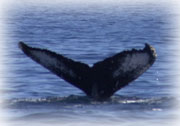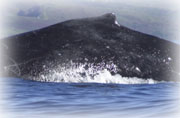
 |
|
| Home | Our Research | Luna / L98 | Active Sonar | Donate & Act Now | About Us | |
|
Unlike other marine mammals (otters, seals, dolphins, even killer whales),
humpback whales are too large to confine in aquariums.
Therefore, we humans have very little time in their company in which to study them.
Internationally, the vast majority of the whale research is dedicated to the (seemingly)
simple task of identification.
Each whale has a unique pattern of pigmentation (the white spots) on the underside of their fluke (their tail) which serves as a 'fingerprint'. By photographing their flukes as they prepare to dive, we can compare these photos to previously taken photos to see if this whale has been seen before. Each photo is logged with the latitude/longitude of the sighting (giving us their position) and the date/time the photo was taken. This information is then entered into our database, and shared with other research organizations. Over the years, we can use this data to describe each group of whales' migratory patterns and social structure. All of these photos were taken during our 2002 field research off Maui, Hawaii. |
 20.82N/156.67W 2002/02/17 |
 20.85N/156.67W 2002/02/14 |
 20.87N/156.81W 2002/02/16 |
 20.83N/156.69W 2002/02/07 |
 20.91N/156.74W 2002/02/07 |
 20.87N/156.81W 2002/02/16 |
|
Although we hope to get clean photos of the underside of each whale's fluke,
this can be a difficult task. Standing in a 10-foot rubber boat, subject to
the wind, waves and the angle of the sun, getting that 'perfect' shot is
not quite so easy. Add this to the fact that whales don't always perform a
fluke-up dive, and you begin to get an idea...
Thankfully, we have a back-up. The small dorsal fins on the backs of whales also carry a distinctive shape. This, combined with any scars which might be present allow us to make positive identification even in absence of a clear view of their flukes. |
 20.87N/156.81W 2002/02/16 |
 20.83N/156.69W 2002/02/07 |
 20.82N/156.67W 2002/02/17 |
| Learn about Whale Acoustic Research |